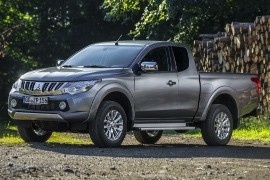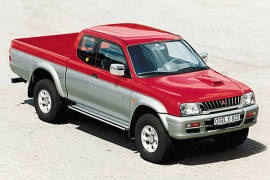
MITSUBISHI L 200
Generations Timeline, Specs and Pictures

The lowest visually appealing of the series, the singe cab provides room for two only but compensates through a larger bed which allows for plenty of cargo storage.
Powered by the same range of engines, the Single Cab version brings nothing new. The latest 2008 model was tested by EuroNCAP standards which deemed it as an overall safe car. The car’s sturdy structure can withstand both frontal and side impact although in the first’s case, risks of major chest and leg injuries have been exposed. However, protection was rated as excellent in the event of a side impact. This is probably the reason why Mitsubishi never fitted the L 200 with side airbags.

The 2015 Mitsubishi L200 Club Cab is the name given to the Crew Cab version of the fifth generation L200 sport utility pickup truck.
And just like its bigger brother, L200 Club Cab got on sale in 2015 coming with more than ever regarding style, equipment and performance.
Visually, the L200 Club Cab got sharper, ditched the bubbly shapes and adopted sharp angles and wide arches to enhance the “sport utility truck”. The interior received an overhauled dashboard, glossy plastic panels as well as redesigned seats. Storage space is not a problem and equipment wise, the L200 comes with almost anything you would find on a standard passenger car - touchscreen infotainment system with multiple connectivity, steering wheel shortcut buttons, electric windows and mirrors, cruise control, lane departure warning, rear view camera, climate control and a lot more.
Mechanically, the chassis has been updated along with the engines, sound insulation and suspension. The 2015 Mitsubishi L200 is also the lightest truck in its class, returns the best fuel economy and can haul a bit more than the competitors.

The 2015 Mitsubishi L200 pickup truck is the fifth generation of the long-trusted Japanese utility vehicle.
It turned its utilitarian spirit more towards comfort, but it didn’t forget its roots and it is still able to carry a one tonne load on top of a mountain. And do it again.
The strictest Euro 6 emission norms are a big pain for most car manufacturers, but for some, it is even harder. The L200 has a specially dedicated engine, which cannot be found on any other vehicle in the carmaker’s small lineup. The 2.4 diesel unit was improved and it now offers 150 hp, while the previous HO option (High-output with 163 Hp) is no longer on the table. Transmissions available are either a 6-speed manual or a 5-speed automatic.
Mitsubishi is well-known in the off-road world for its Super-Select 4x4 system, which is unique on the market with its capabilities to shift and lock differentials in off-roading.
Special attention was given to the cockpit, where five passengers can fit easily. The rear bench seat is not the most comfortable place in the vehicle industry, though, due to its almost vertical backrest. The infotainment unit provides Apple CarPlay and Android Auto, plus a navigation system and special dedicated off-road programs.

The second generation of the L200, named Triton on specific markets, brought a new design language for the trustworthy Japanese pickup and improved drivetrains.
With the second generation of the L200, Mitsubishi tried to offer more than just a rugged workhorse. It introduced the vehicle as a lifestyle pickup, with a more refined design than its predecessor. But it kept its rough off-road abilities while it offered a different look than a farm tractor.
In the Crew-Cab version, the L200/Triton featured a new design language, with rounded shapes and sharp angles. Its raked grille and pentagonal headlights were unusual for a pickup. Its plastic, wrapped-around bumper sported the grille mounted on a body-colored vertical slat in the middle of the grille. The crew cab was more extended than the single cab version, but it offered just two doors. Thus, it could provide more interior room than the single cab, but it still had a 2220 mm (7.3 ft) long bed, which was more than what the double-cab could provide.
Inside, the carmaker installed a pair of bucket seats at the front separated by a tall center console with an armrest. Regardless of the trim level, it featured the same hard-plastic dashboard, which reminded the customers that it could do hard-working jobs. Behind the front seats, the carmaker added a storage area. Also, thanks to the more extended cabin, the front seats could still tilt while they were all the way pushed back.
Under the hood, depending on the market, Mitsubishi installed various engines. The L200 was available with either a choice of four engines. Two turbo-diesel versions, a 2.5-liter or a 3.2-liter, or two gasoline powerplants with 2.4-liter or 3.5-liter displacement.

The Double Cab is no different form the other two versions with very few exceptions such as a larger cabin that provides comfortable seating for four and a shorter load bed.
The pick-up truck’s XXL size make it pretty impressive not to mention safe on the road, especially on European routes where large cars like the L 200 are not that of a common sight as in the US. Its largest 3.5 L V6 offers the line-ups highest output of 178 hp and 218 Nm of max torque. Although not the best figures for a car in its class, the L 200 is still a reliable, surprisingly well finished vehicle that can do just as fine as others in a variety of tasks.

The third generation of the pickup range in Mitsubishi was an important step forward for the Japanese carmaker, which gave it a split personality as a workhorse and leisure vehicle.
While its first pickup generation was more of an underpowered Ford Ranchero, the second generation was the transition toward a 4x4 utility vehicle. Also, it tried to adapt it and make it friendlier with its users and gave them a few comfort features. But the third one was designed right from the start as a true, multipurpose vehicle.
Its design showed softer edges and curved lines over the front end and door panels. But it didn’t forget its origins and tried to be also a rugged, go-anywhere vehicle. The carmaker made it available as a Single-Cab, Crew-Cab and Double-Cab, with the former being offered as the entry-level version with the longest bed.
Inside, the base version also offered a blue-collar interior, with cloth seats, cranked windows and plastics hard and badly finished. But, at the end of the day, that vehicle had the job done without complaints. It could carry one metric ton and still didn’t complain about minimum wage or lunch break. Unlike its bigger brothers, who offered wider cabins, the single-cab version provided room for two with a center console between them and a gear-stick that popped up through the floor. Depending on the trim level and version, it could have been fitted with air-conditioning and power windows and mirrors.
Under the hood, Mitsubishi installed a 2.5-liter turbo-diesel engine paired with a five-speed manual. Depending on the market, it was available with a rear or 4x4 system with a low-range gear.

With an increased demand in the pickup segment and a big experience in building 4x4 vehicles, the L200 Double Cab was a good mix between a workhorse and a leisure vehicle for a family.
While its previous generations were more like test-beds for a future best-seller, the third was the right pickup to wear the Mitsubishi badge. It was big enough for five adults, with a decently-sized bed in the back and a trusted platform that could take the vehicle on any rough terrain.
Its design showed softer edges and curved lines over the front end and door panels. But it didn’t forget its origins and tried to be also a rugged, go-anywhere vehicle. The four-door version featured a longer cabin, fit for five adults. Despite being an all-terrain vehicle, it showed smoother lines on the bodywork and curved panels. The only rectangular shape, yet rounded on the corners, was found on the headlights, which were well-protected in deeper clusters. As an option, Mitsubishi offered chromed bush-guards and a sturdy roll-bar mounted behind the cabin.
Inside, the base version also offered a blue-collar interior, with cloth seats, cranked windows, and plastics hard and badly finished. It could carry one metric ton and still didn’t complain about minimum wage or lunch break. But most customers went for better-equipped vehicles that provided air-conditioning and power windows and mirrors. The L200 provided room for five with a center console between the front occupants and a flat floor in the back.
Under the hood, Mitsubishi installed a 2.5-liter turbo-diesel engine paired with a five-speed manual. Depending on the market, it was available with a 4x4 system with a transfer box and low-range gear.

Mitsubishi introduced the second generation of the L200 in 1995 and offered it in three cab versions, with the Crew-Cab positioned between the two-seat Single-Cab and the five-seat Double-Cab.
Sometimes, a contractor needed more workers for a job, but most of the time, he needed more loading area. In that situation, he wouldn’t choose a double cab, which was more expensive, nor a single cab since it didn’t have any rear seats. The Crew-cab offered a lower price than its four-door sibling, but it still had enough loading area for tools and materials.
Its design showed softer edges and curved lines over the front end and door panels. But it didn’t forget its origins and tried to be also a rugged, go-anywhere vehicle. Unlike other American pickups, the L200 didn’t have rear-hinged half-doors in the back; it only had two regular doors. Despite being an all-terrain vehicle, it showed smoother lines on the bodywork and curved panels.
Inside, the base version also offered a blue-collar interior, with cloth seats, cranked windows, and plastics hard and poorly finished. It could carry one metric ton and still didn’t complain about minimum wage or lunch break. The pop-out rear windows were more than enough to cool the cabin if the owner didn’t opt for an AC unit. But Mitsubishi offered the Warrior top-spec version on selected markets. That one was mainly for those who needed just a two-seat pickup with more room behind the seats for luggage and a bed where they could load a pair of bikes.
Under the hood, Mitsubishi installed a 2.5-liter turbo-diesel engine paired with a five-speed manual. Depending on the market, it was available with a 4x4 system with a transfer box and low-range gear.























































